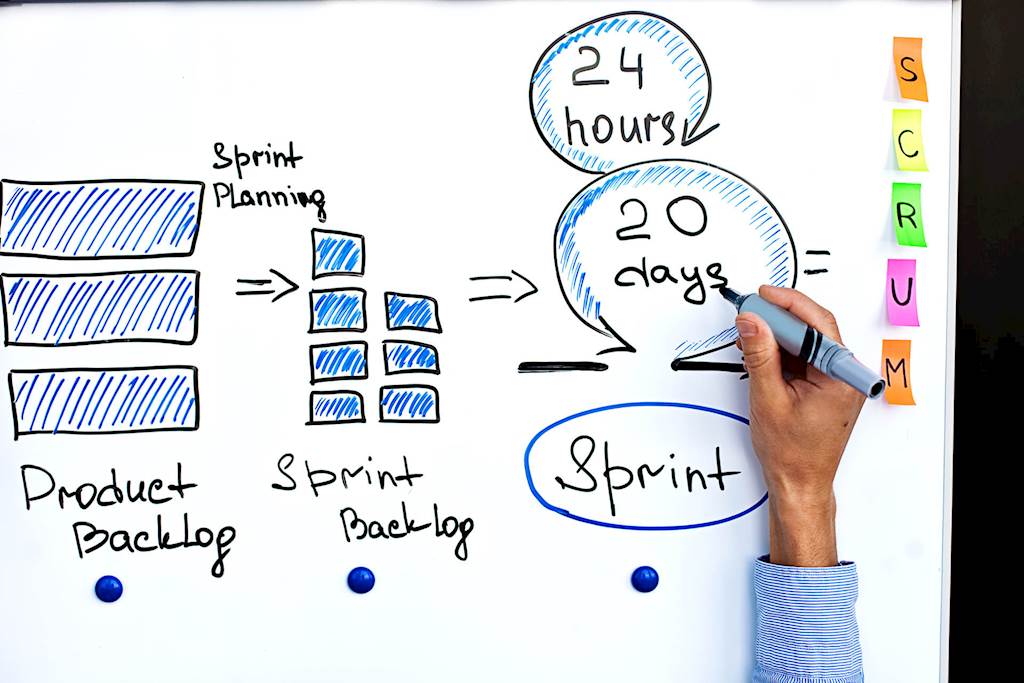Agile working has become a hot topic for businesses but can it work for marketing? As with most teams, it's key that all professionals are able to work effectively and efficiently together, but also have the autonomy needed to succeed independently. This is crucial for getting the most out of your team and reaching your business objectives.
Is agile the secret to success or just a recipe for disaster?
What is agile?
Agile is described by Microsoft as a working method that focuses on "incremental delivery, team collaboration, continual planning, and continual learning", and has been used consistently in software development for years.
It was first coined in 2001 in the Agile Manifesto, which set out four key elements:
- Individuals and interactions over processes and tools
- Working software over comprehensive documentation
- Customer collaboration over contract negotiation
- Responding to change over following a plan
Agile working aims to break down traditional team mentality, where everyone from one discipline is put together. Instead, it builds teams with varied skills and expertise and encourages them to work collaboratively together.
The main event of agile is the 'Sprint', where teams focus solely on the same singular project or task. These Sprints are usually preceded and followed by meetings, as well as daily "stand-ups" to keep everyone on the same track.
The idea is that by working on shorter chunks of work, your team will be more efficient and not suffer "burnout". Agile aims to optimize how professionals work, making the most of their time and creating the most effective environment for them to work in.

Terminology definitions
To fully understand agile and how it works, here is the terminology you need to know.
Project Owner
This is the person who is in charge of conceptualizing a project and determining what goals said project needs to meet. They are in charge of coming up with a clear vision to present to the team.
Scrum
A framework that marketing teams can use to address large complex projects and break them down into smaller pieces to increase productivity and avoid missed deadlines.
Scrum Master
The person who oversees the entire scrum team and ensures that everyone is working productively. They communicate the capacity and velocity of the scrum team to the project manager to plan effective Sprints.
Scrum Team
A group of five to nine people who are responsible for executing the tasks in a project that have been assigned to them by the scrum master.
Sprint
A length of time that the scrum team commits to completing a certain amount of work within.
Sprint Backlog
Tasks and projects that have been moved from the project backlog that a scrum team will commit to completing within a sprint.
Sprint Cycle
A two- to four-week time frame that a full sprint is completed in.
Sprint Planning Meeting
A time where the project owner, scrum master, and scrum team get together to assign work for the upcoming sprint.
Sprint Review/Retro
A time to review what went well in the sprint and what didn’t, as well as address why work was or was not completed on time.
How can agile help marketing teams?
Because marketing evolves quickly, agile working can be especially useful, allowing teams to adapt to changing demands, budgets or even an unexpected event. Teams will need to plan their processes in the meetings before the Sprint, giving them strong foundations to work from, while allowing them the flexibility they need.
By looking at the project as a whole, with various specialists involved, you can more accurately divide up the work that needs to be completed. Agile also forces people to set goals and objectives right at the start, which is an integral part of marketing. It complements marketing so well because it requires professionals to be specific about their objectives, workload, time and budget. It also encourages teams to be critical about their own work to identify areas where improvements could be made or the overall efficiency of the project boosted.
8 tips for agile success
For marketing teams to really benefit from agile working, her are 8 tips for success:
1. Use the right tools
You may find communication tools like Slack or Trello help your team work more effectively in Sprints, while keeping an accurate record of what tasks have been completed and which are still pending.
2. Plan first
Invest time in the Sprint planning process as this will have the biggest impact on whether agile works for the team or not.
3. Create independence within the team
Agile works best with professionals who are able to work confidently by themselves but also have the ability to communicate with others and collaborate. Think about these attributes before selecting a team to Sprint.
4. Establish what does complete means
It may sound simple but different professionals may have different definitions of when a task is finished. Make sure this is clarified before the Sprint starts.
5. Check availability
If not everyone in the company is involved in the Sprint, it's a good idea to have Sprint members put it in their online calendar to avoid distractions, as well as closing their email and setting their OOO.
6. Define who is responsible for what
Defining roles like Project Owner and Scrum Master is important to keep things running as efficiently as possible.
7. Give it structure
Structure the daily meetings or stand-ups to ensure they run smoothly. Ideally, they're supposed to last no longer than 15 minutes but need to have time for everyone in the team to speak.
8. Don't neglect the review stage
After every Sprint, teams should identify any difficulties or challenges they experienced that - if fixed - could make them more productive next time.
Access the latest business knowledge in Marketing
Get Access





Comments
Join the conversation...